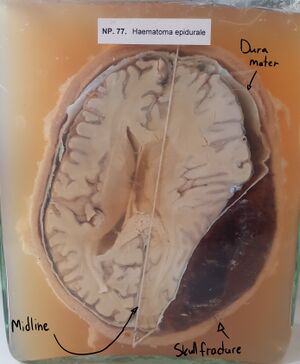31. Epidural haemorhage
Organ: Brain, skull
Description:
A large haematoma lies between the skull and the dura mater in the bottom right corner. It has a biconvex shape. A skull fracture can be seen. A small rope shows the midline of the patient. This rope helps illustrate that the haemorrhage compresses the brain, which can be seen as the right ventricle is pushed to the left of the midline rope.
Diagnosis: Epidural haematoma
Causes:
- Blunt force trauma -> skull fracture -> middle meningeal artery ruptured
Theory:
Biconvex shaped haematoma is characteristic for epidural haematoma. The haematoma compresses the brain and may causes the cerebellar tonsils to herniate through the foramen magnum, which compresses the lower brainstem. This is called tonsillar herniation and causes respiratory failure by compressing the respiratory centre.

